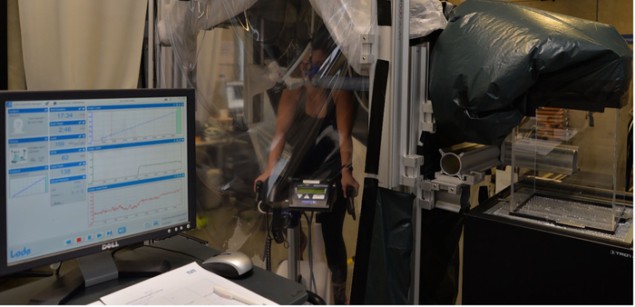
The number of aerosol particles exhaled by people who are exercising increases 132-fold on average during periods of peak physical activity. This finding, from researchers at the Universität der Bundeswehr München in Germany, may help explain reports of high transmission of the SARS-CoV-2 virus in poorly ventilated indoor spaces such as gyms, and might also aid in the development of measures to reduce such transmission.
A graded exercise test
In the new work, scientists led by fluid-dynamics expert Benedikt Mutsch developed a way to measure the concentration of aerosol particles in expired (that is, breathed-out) air as people exercise more intensely – “from rest to exhaustion”, as they describe it. Using this method, they tested a group of 16 healthy volunteers – eight men and eight women – aged between 21 and 40. Seven of these volunteers were considered fitter than the others based on their measured VO2max, which is the maximum volume of oxygen (in millilitres) that can be metabolized under load.
The volunteers undertook a graded exercise test on a piece of equipment called a cycle ergometer that was located in a tent containing a reduced concentration of aerosol particles in the ambient air. During this test, volunteers in this “clean air tent” inhaled filtered air with very low aerosol particle concentration. Starting from rest, the researchers measured the subjects’ ventilation and aerosol particle concentration directly in the air they exhaled.
Big increases in aerosol concentration
Mutsch and colleagues found that the concentration of aerosol particles in the air expired by the volunteers increased significantly with exercise, rising from 56 +/– 53 particles/litre when they weren’t exercising to 633 +/– 422 particles when they were. Aerosol particle emission per subject also increased by a factor of 132 on average, rocketing from 580 +/– 489 particles/minute at rest to a “superemission” of 76,200 +/– 48,000 particle/min during times of peak exertion. The results were roughly the same for men and women, but there was a twist: the fitter volunteers exhaled many more aerosol particle particles during maximal exercise than did the other participants.
These results imply that aerosol particle emission increases exponentially above moderate exercise intensity, resulting in superemission during maximal exercise intensity, say the researchers. The new data might also partly explain so-called superspreader events, when large numbers of people are infected simultaneously by a small number of infectious individuals. Several such events have been reported during high-intensity group exercise in indoor spaces like gyms, they add, suggesting that measures need to be taken to prevent disease transmission between people who are exercising in these spaces.

Physics points the way to COVID-safe singing
“Mitigation measures might be adjusted to high-risk settings, for example,” Mutsch tells Physics World. “The aim should be to define criteria to make exercise safe.”
Steps for reducing risk
In situations of high risk of infection, the most important steps to take, according to Mutsch, are keeping a safe distance from others; ensuring that a good mechanical ventilation (HVAC) is in place; ventilating rooms by opening doors and windows; wearing face masks whenever physical distancing is not possible (for example, in changing areas); reducing the time spent in spaces where people are exercising with high intensity; and finally limiting the number of people in a given space.
The researchers, who report their work in PNAS, are now investigating a larger group of subjects – up to 80 – spanning different age groups and body-mass indices (BMIs), since there is some evidence that age and BMI may influence the amount of aerosol particle emission. “We also want to study what happens during resistance exercise, since the way people inhale and exhale might be different here,” says Mutsch.



